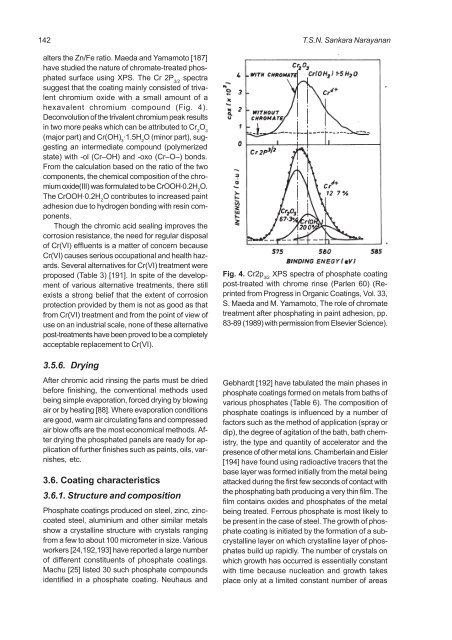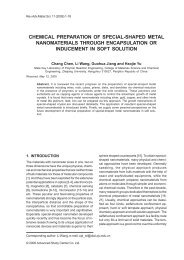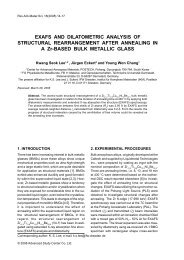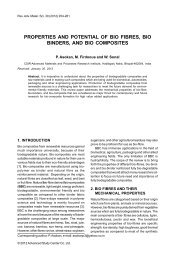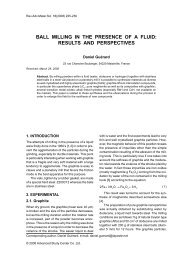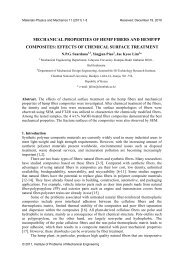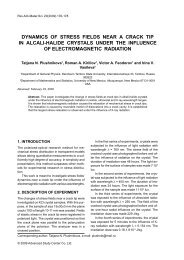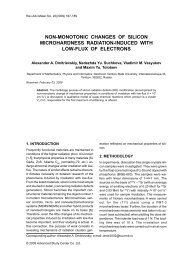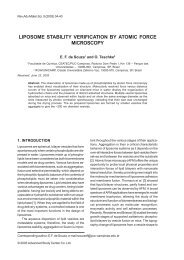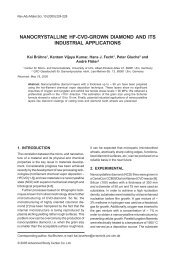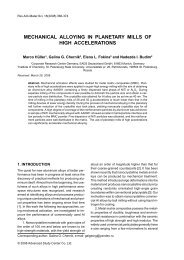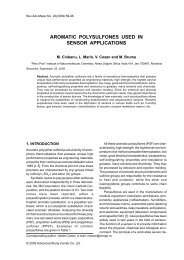surface pretreatment by phosphate conversion coatings – a review
surface pretreatment by phosphate conversion coatings – a review
surface pretreatment by phosphate conversion coatings – a review
You also want an ePaper? Increase the reach of your titles
YUMPU automatically turns print PDFs into web optimized ePapers that Google loves.
142 T.S.N. Sankara Narayanan<br />
alters the Zn/Fe ratio. Maeda and Yamamoto [187]<br />
have studied the nature of chromate-treated <strong>phosphate</strong>d<br />
<strong>surface</strong> using XPS. The Cr 2P spectra<br />
3/2<br />
suggest that the coating mainly consisted of trivalent<br />
chromium oxide with a small amount of a<br />
hexavalent chromium compound (Fig. 4).<br />
Deconvolution of the trivalent chromium peak results<br />
in two more peaks which can be attributed to Cr O 2 3<br />
(major part) and Cr(OH) . 1.5H2O (minor part), sug-<br />
3<br />
gesting an intermediate compound (polymerized<br />
state) with -ol (Cr<strong>–</strong>OH) and -oxo (Cr<strong>–</strong>O<strong>–</strong>) bonds.<br />
From the calculation based on the ratio of the two<br />
components, the chemical composition of the chromium<br />
oxide(III) was formulated to be CrOOH . 0.2H O. 2<br />
The CrOOH . 0.2H O contributes to increased paint<br />
2<br />
adhesion due to hydrogen bonding with resin components.<br />
Though the chromic acid sealing improves the<br />
corrosion resistance, the need for regular disposal<br />
of Cr(VI) effluents is a matter of concern because<br />
Cr(VI) causes serious occupational and health hazards.<br />
Several alternatives for Cr(VI) treatment were<br />
proposed (Table 3) [191]. In spite of the development<br />
of various alternative treatments, there still<br />
exists a strong belief that the extent of corrosion<br />
protection provided <strong>by</strong> them is not as good as that<br />
from Cr(VI) treatment and from the point of view of<br />
use on an industrial scale, none of these alternative<br />
post-treatments have been proved to be a completely<br />
acceptable replacement to Cr(VI).<br />
3.5.6. Drying<br />
After chromic acid rinsing the parts must be dried<br />
before finishing, the conventional methods used<br />
being simple evaporation, forced drying <strong>by</strong> blowing<br />
air or <strong>by</strong> heating [88]. Where evaporation conditions<br />
are good, warm air circulating fans and compressed<br />
air blow offs are the most economical methods. After<br />
drying the <strong>phosphate</strong>d panels are ready for application<br />
of further finishes such as paints, oils, varnishes,<br />
etc.<br />
3.6. Coating characteristics<br />
3.6.1. Structure and composition<br />
Phosphate <strong>coatings</strong> produced on steel, zinc, zinccoated<br />
steel, aluminium and other similar metals<br />
show a crystalline structure with crystals ranging<br />
from a few to about 100 micrometer in size. Various<br />
workers [24,192,193] have reported a large number<br />
of different constituents of <strong>phosphate</strong> <strong>coatings</strong>.<br />
Machu [25] listed 30 such <strong>phosphate</strong> compounds<br />
identified in a <strong>phosphate</strong> coating. Neuhaus and<br />
Fig. 4. Cr2p 3/2 XPS spectra of <strong>phosphate</strong> coating<br />
post-treated with chrome rinse (Parlen 60) (Reprinted<br />
from Progress in Organic Coatings, Vol. 33,<br />
S. Maeda and M. Yamamoto, The role of chromate<br />
treatment after phosphating in paint adhesion, pp.<br />
83-89 (1989) with permission from Elsevier Science).<br />
Gebhardt [192] have tabulated the main phases in<br />
<strong>phosphate</strong> <strong>coatings</strong> formed on metals from baths of<br />
various <strong>phosphate</strong>s (Table 6). The composition of<br />
<strong>phosphate</strong> <strong>coatings</strong> is influenced <strong>by</strong> a number of<br />
factors such as the method of application (spray or<br />
dip), the degree of agitation of the bath, bath chemistry,<br />
the type and quantity of accelerator and the<br />
presence of other metal ions. Chamberlain and Eisler<br />
[194] have found using radioactive tracers that the<br />
base layer was formed initially from the metal being<br />
attacked during the first few seconds of contact with<br />
the phosphating bath producing a very thin film. The<br />
film contains oxides and <strong>phosphate</strong>s of the metal<br />
being treated. Ferrous <strong>phosphate</strong> is most likely to<br />
be present in the case of steel. The growth of <strong>phosphate</strong><br />
coating is initiated <strong>by</strong> the formation of a subcrystalline<br />
layer on which crystalline layer of <strong>phosphate</strong>s<br />
build up rapidly. The number of crystals on<br />
which growth has occurred is essentially constant<br />
with time because nucleation and growth takes<br />
place only at a limited constant number of areas


